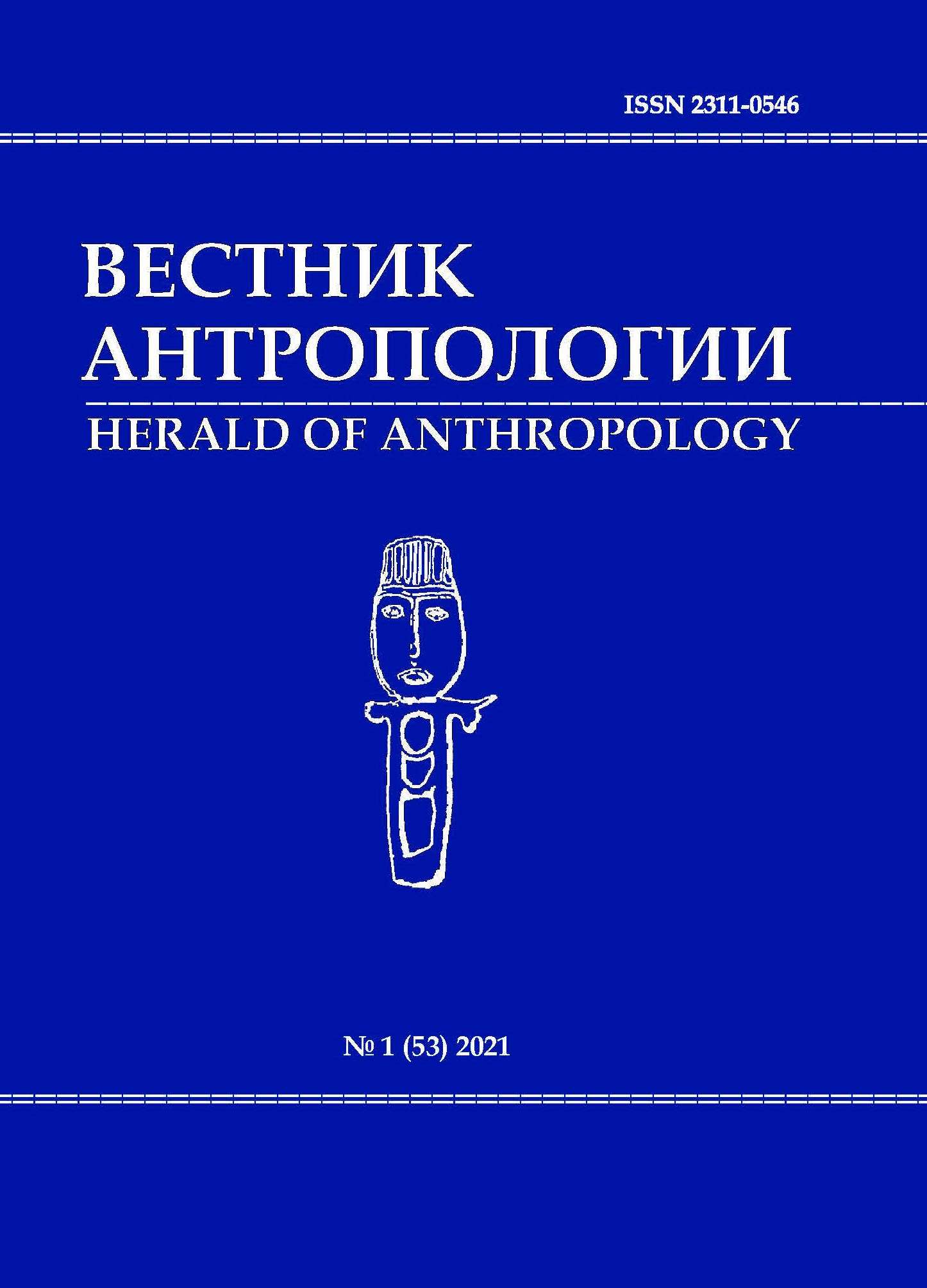Between Asia and Australia (craniological diversity of the cerebral skull of the modern population of Southeast Asia)
DOI: 10.33876/2311-0546/2021-53-1/166-182
Keywords:
skull, cranioseries, craniotype, SundidsAbstract
This work continues the studies devoted to the worldwide classification of modern humans by the neurocranial skull. Cranial dimensions of population of vast territories of Southeast Asia, Australia and the islands between these continents were studied. The study was based on a comparative analysis of individual data from male skulls from 32 samples, taken from published works of anthropologists who studied this region. The dendrogram of the distances between these 32 samples, based on 11 measures of the size and shape of the skull, is formed by three distinctive clusters. Samples from the first cluster are characterized as typical for the Pacifid craniotype (mesocranial skulls). Samples from the second cluster belong to the East Tropid craniotype (dolichocranial skulls). Samples from the third cluster differ both from the two craniotypes mentioned above and another craniotype, called Golarktids (this type is not presented in the studied area). We called this last cluster “Sundids”, because they are mainly localized in the Sunda subcontinent. This area was formed during the sea regression during the Pleistocene, when the shelf seas of Southeast Asia and Indonesia turned into land, part of a single Eurasian continent. In this sample, the skulls are small and brachycranial. A large part of Indochinese and Indonesian crania can be attributed to this craniotype. Thus, the great Mongoloid race can be divided into three different craniological types: continental Mongoloids (Golarktids), Pacific Mongoloids (Pacifids), and southern Mongoloids (Sundids).
For Citation: Pestriakov, A.P.. O.M. Grigoryeva and Y.V. Pelenitsyna. 2021. Between Asia and Australia (neurocranial diversity of the modern population of Southeast Asia). Herald of Anthropology (Vestnik Antropologii) 1 (53): 166–182.
References
- Alexejev, V. P. 1973. Craniological material from new Guinea, Indonesia and the Malayan Peninsula Anthropologie. Moravske Muzeum – Ustav Anthropos, 201–248. Brno.
- Alekseev, V.P. 1974. Materialy po kraniologii Novoj Gvinei, Zondskih i Molukkskih ostrovov, Malajskogo poluostrova [Materials on the craniology of New Guinea, the Sunda and Moluccas Islands, and the Malay Peninsula]. Kul’tura narodov Avstralii i Okeanii. Sbornik
- Muzeya antropologii i etnografii, XXX, 187–236. Leningrad: Nauka, Leningradskoe otdelenie.
- Alekseev, V.P. 1982. K kraniologii bengal’cev [To the craniology of Bengalis]. Novye materialy k antropologii Zapadnoj Indii: Rezul’taty sov. Issledovanij, 301–312. Moscow: Nauka.
- Alekseev, V.P., and Gohman I.I. 1984. Antropologiya aziatskoj chasti SSSR [Anthropology of the Asian part of the USSR]. Moscow: Nauka.
- Bonin, Gerhard von. Beitrag zur Kraniologie von Ost-Asitn. 1931. Biometrika 21 (1/2): 52–113.
- Cheboksarov, N.N. 1951. Osnovnye principy antropologicheskoj klassifikacii [Basic principles of anthropological classification]. TIE (nov. ser.), XVI. Moscow; Leningrad.
- Cheboksarov, N.N. 1882. Etnicheskaya antropologiya Kitaya [Ethnic Anthropology of China]. Moscow: Nauka, Glavnaya redakciya vostochnoj literatury.
- Debec, G.F. 1951. Antropologicheskie issledovaniya v Kamchatskoj oblasti [Anthropological research in the Kamchatka region]. Trudy Severo-vostochnoj ekspedicii, 1. Moscow: Izd-vo Akademii nauk SSSR.
- Dodo Yukio, at all. 2001. Metric Data of Ryukyunan Crania. Anthropological Sciense 109 (2): 182–190.
- Hambly, Wielfred D. 1946. Craniology of Ambrim Island. Fieldiana: Anthropology 37 (1): 1–46. Chicago.
- Harrower, Gordon. 1925. A Study of the Hakian and Tamil Scull, 1–31. Singapore: Appendix.
- Howells, W.W. 1995 Who`s Who in Skulls. Ethnic Identification of Crania from Measurements. Papers of the Peabody Museum of Archaeology and Ethnology 82: 108. Cambridge, Mass.: Peabody Museum.
- Howells, W.W. Craniometric data set. http://web.utk. edu/~ auerbach/HOWL.htm.
- Hrdlicka, A. 1928. Catalogue of human crania in the United States national museum collectilns. Procceedings of the of the United States national museum 71.Washington.
- Morant, G. M. 1924. A Study of certain series including the Nepalese and Tibetan series in the British Museum (Natural History). Biometrika 16, 1/2 (May 1924): 1–105.
- Newman, M.T. 1949. The Sequence of Indian Physical Types in South America. Papers on the Physical Anthropology of the American Indian 21: 69–97. New York.
- Pestriakov, A.P., and O.M Grigoryeva. 2004. Kraniologicheskaia differentsiatsiia sovremennogo naseleniia [The craniological differentiation of the contemporary population]. In: Rasy i narody, 30: 86–131. Moscow: Nauka.
- Pestryakov, A.P., and O.M Grigoryeva.2011. Nekotorye dannye po kraniologii naseleniya Yaponskih ostrovov [Some data on the craniology of the population of the Japanese Islands]. Vestnik antropologii. Nauchnyj al’manah 20: 23–35.
- Pestryakov, A.P., and O.M Grigoryeva. 2013. Avstralijskie aborigeny na kraniologicheskom fone naseleniya YUzhnoj i YUgo-vostochnoj Azii i Zapadnoj Okeanii [Australian aborigines on the craniological background of the population of South and South-East Asia and Western Oceania]. Vestnik Moskovskogo universiteta. Seriya Antropologiya, XXIII, 2: 17–33. Moscow.
- Tidesley, M.L. 1921. A first Study of Burmese Skull. Biometrika. 13, 2/3 (Jul. 1921): 176–262.





















